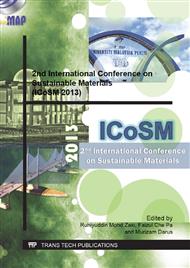p.290
p.294
p.299
p.304
p.308
p.313
p.318
p.324
p.329
Long Physico-Chemical and Biological Monitoring for Treated Artificial Tidal Flats with Recycled Paper Sludge in Ago Bay, Japan
Abstract:
Treated dredged sediment by using Hi Biah System (HBS) was used for the construction of five different artificial tidal flats (E1-E5) in Ago Bay, Japan. AGOCLEAN-P which is mainly made from paper sludge ashes was used as a coagulant and hardener. After the construction, continuous monitoring for the physico-chemical and biological parameters was carried out quarterly for 28 months from May 2005 to August 2007. Physico-chemical parameters measured were; particle size, loss on ignition (LOI), total organic carbon (TOC), chemical oxygen demand (COD), water content (WC), chlorophyll a, and acid volatile sulphide (AVS). At the end of the experiment, physico-chemical parameters for the artificial tidal flats along with the sandy natural flat (S2) were almost similar. In regards to the natural muddy flats (S1) the results showed remarkable increase in the particle size <0.75 μm throughout the experimental period, whereas insignificant decrease was observed for the medium particle size. In addition the area around station (S1) was characterized by high concentration of silt/clay around 75% for the particle size less than 75μm. Biological parameter was represented by macrobenthos abundant as number of individuals, biomass, and species number. The abundant macrobenthos during the first year of monitoring was mollusca followed by polychaeta then bivalve, however at the end of the experiment, bivalve was the most dominant macrobenthos followed by mollusca and then polychaeta indicating that healthy environment was created.
Info:
Periodical:
Pages:
308-312
Citation:
Online since:
September 2013
Permissions:
Share:
Citation:


